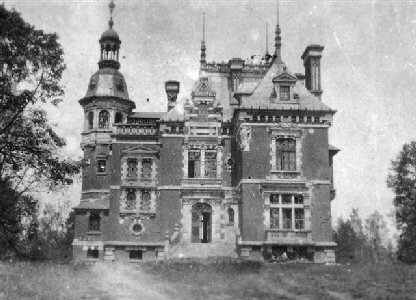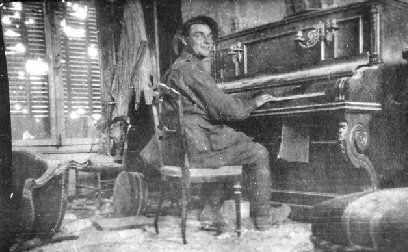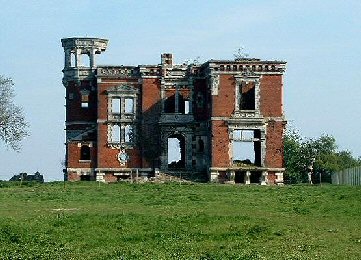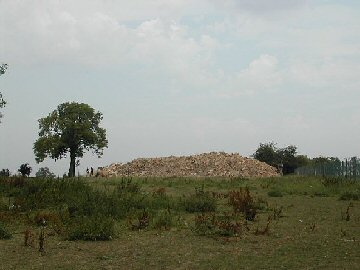PHILIP EAGLES
![]()
Whilst in France and Belgium during 1916-1918 my great-uncle George Jessop, a gunner with the 38th battery of the Australian artillery, took many photographs of the battlefields, of tanks, trenches, aircraft and soldiers. Two of the photographs are reproduced here, the originals being in the collection of the Australian War Memorial, Canberra. The first photo, probably taken around mid-1918, shows a rather eerie chateau. In the first draft of this article I was posing the question as to whether anyone knew of its whereabouts and history? I soon found a news item which identified the building as the "Red Chateau" (Chateau Delacour) near Villers-Bretonneux - apparently the chateau had been 'in the news' as the local council wanted to demolish it and sell the land for the construction of a supermarket!
A subsequent search of the 'web' revealed that the chateau was in fact demolished in early August 2004 and had been the subject of some discussion on "The Great War Forum" where a photo revealed its final fate as a pile of rubble worthy of a Great War battlefield.
The photo here reveals the chateau as it was around mid-1918. The exterior of the building shows signs of war damage, the windows and some of the brickwork being riddled with holes. A photo sent to me by Tom showed the chateau many years later with the same battle damage to the walls but with the rest of the building in an advanced state of disrepair, the roof and towers having disappeared.

In the photo shown below, gunner Jim Booth, 38th battery Australian Artillery, is sitting at a piano inside the chateau amongst scattered damaged furniture. Notes on the back of the original picture suggest the building was used as an observation post by the 10th Australian Field artillery Brigade and that there may also have been some connection with the French Marshal Foch.

Having solved the identity of the 'mystery chateau' I was still interested to know who were its owners and why did it continue to fall into disrepair after the war? Why in 1918, would the chateau have been abandoned by the owners, who were presumably 'well off', leaving much of the furniture inside? The building was largely intact back then, so was it caught up in the rapid German advances of early 1918 and left in haste? And what was its association, if any, with Marshal Foch?


Red Chateau, Villers-Bretonneux, before and after demolition
The 'Red Chateau' or 'Chateau Delacour' belonged to the Delacour family who owned a number of estates around France. One of their sons Jean Delacour (1890-1985) spent much of his early life at the Villers-Bretonneux estate which included fine gardens, a park and aviaries which Jean designed and stocked with exotic birds from around the world. Fascinated from childhood by the world of nature, he regarded the estate in those days before the outbreak of the First World War as his "earthly paradise".
When the war began, Jean, then twenty-four years old, was called up for military service with the French army and while away in August 1914 he learned that Villers-Bretonneux had been overrun by the Germans as they marched on Paris. After the battle of the Marne they fell back fortunately leaving the chateau largely unscathed. Jean recalled in his memoirs:
"Some looting had taken place, but on the whole little serious damage was done.
Wine and silver had suffered most of the onslaught....there was some heavy fighting ten miles to the east of Villers....lines of trenches were finally established and from that time on the chateau never ceased to be an Army, Army Corps, or Divisional Headquarters."
Away from home for much of the next two years Jean returned to the estate in 1916:
"Except for the troops who were everywhere, all had remained much as I had left it....the aviaries and greenhouses looked intact: plants and birds flourished...the famous and colourful General Mangin and his staff lived in the house...it was a new experience for me to be entertained by others in my own home, and as a simple Lieutenant, to be treated as an honoured guest by high ranking Generals!"
Not long after, the battle of the Somme was raging and the French General Foch, later to become commander of the allied forces, took up residence at the chateau. Jean who was stationed nearby was able to visit and often found the General and his Chief of staff strolling in the gardens as they discussed operations and strategies. Foch stayed at the chateau until the end of 1916 and during that time Jean met a number of famous visitors there including Prime Minister Lloyd George and Field Marshal Haig.
During the winter of 1917-1918 the British Fifth Army under General Gough established headquarters at the chateau. The Germans were forty miles away and it seemed the estate would survive the rest of the war without further damage. But the German onslaught of March 1918 shattered Fifth Armies' front and they drove on relentlessly towards Villers-Bretonneux. Jean, realising that the town would be lost, paid a visit shortly before the chateau was once more overrun.
"...the town was still intact, but empty, and the first shells were beginning to fall. I entered the grounds of the chateau....For an hour I walked through the gardens, the aviaries and the park, I went over all the rooms, full of artistic treasures and familiar objects. I took a long look at those cherished possessions, but there was such a short time to stay and so little room in the car that I did not take with me a single souvenir...I said goodbye to the beloved place, which I was never to see again as it had stood for so long."
For months, attacks and counterattacks raged around Villers-Bretonneux as the Germans desperately sought to break through only to be stopped by the allied forces. Finally, in August 1918, they were driven back for the last time and Jean returned again to the chateau, but this time the ravages of war had taken their toll:
"The sight was dreadful: stumps of trees and crumbling walls and waste. Where the gardens, conservatories and aviaries had been, only tangles of broken steel, glass and wood remained. Shell holes...were all around...Not a square yard remained untouched...From that day Villers never meant anything to me. It was so disfigured that it did not bring back any recollection of a happy past."
And so, after the war, the Delacour family presented the estate to the municipality and Jean Delacour moved on to greater things, dividing his time between France, the United States and ornithological expeditions around the world. The chateau was left to its fate.
The photo shown above of the chateau's exterior, taken by Gunner George Jessop around mid-1918, seems to show it damaged but largely intact and in the interior shot we can see some of those "familiar objects" Jean referred to in his last visit. By the time of the chateau's demolition in 2004 it appears little remained of the building but a crumbling shell. A sad end for Jean Delacour's childhood "earthly paradise".
Reference:
The Living air. Memoirs of an ornithologist. By Jean Theodore Delacour. Country
Life. London. 1966.
Acknowledgements:
Black-and-white photographs reproduced by kind permission of The Australian
War Memorial Canberra.~
Colour photographs by kind permission of Nicolas Goret
For a direct link to the author of this article, email Philip Eagles
![]()
 Copyright © Philip Eagles,
September, 2004.
Copyright © Philip Eagles,
September, 2004.
Return to the Hellfire Corner Contents Section